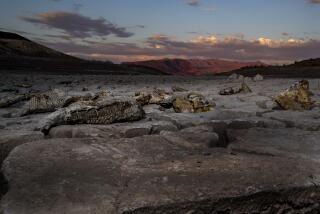‘Big dry’ withers Outback farming
- Share via
CANBERRA, AUSTRALIA — Grain farmer Eddie Valks hosted his daughter’s wedding on his 2,000-acre spread northwest of Sydney, complete with bride and groom sailing off on a small lake.
Four years later, the lake is gone, dried out by Australia’s worst drought on record.
“If the wedding guests from the cities saw the place now, they’d be shocked,” said Valks, 61.
Drought and flood have been familiar features of Australia’s vast cattle and sheep ranches and shimmering grain fields since the first Europeans settled here more than 200 years ago.
But this “big dry” is the worst and widest, officials say, and poses a massive economic challenge. It could bring lasting changes to the Earth’s driest inhabited continent and sharpen a debate about whether drought-hit farmers should simply leave for rainier parts of the country.
It is also putting pressure on Prime Minister John Howard from those who link the drought to global warming. Critics condemn his center-right coalition for joining the United States in refusing to ratify the Kyoto Protocol on reducing greenhouse gas emissions.
Several cities and regions from the west to the east coasts are experiencing their driest year on record. Reservoirs were already low at the outset of 2006, with some areas enduring below-average rainfall for the past decade.
David Dreverman, a leading water conservation scientist, says such a drought comes once in 1,000 years.
Dreverman, manager of the government commission that monitors water flows in the Murray and Darling rivers, a system that sustains 40% of Australia’s farming, has told state government leaders that inflows this year were 54% below the last record low -- by far the biggest drop on record.
The Australian Bureau of Agricultural and Resource Economics, a government commodities research agency, predicts that harvests of wheat, barley and canola will cut the nation’s grain earnings by $4.7 billion, or 35%, this fiscal year, which began July 1.
Australia is usually the world’s largest wheat exporter after the United States and Canada, but a lack of winter rain across the southeast means that only 10.5 million tons will be harvested, the smallest crop in more than a decade. That compares with 28 million tons the previous year.
The bureau also estimated that the drought would shave 0.7 percentage points from the government’s economic growth forecast of 3.25% for the year ending June 30, 2007.
At Gunnedah, 280 miles northwest of Sydney, grain crops have failed and ranchers are selling livestock because they can’t afford feed.
Andrew Higham, who raises cattle on 3,000 acres near Gunnedah, says weather swings are unpredictable.
“It’s certainly more extreme. When we do get rain, it seems to come down altogether, and when it’s dried up, it stays dry for extended periods,” he said. “It’s definitely changed.”
The government in October increased welfare and subsidies to 72,000 farmers -- about half the nation’s total.
“I don’t know that we’ve seen this much of Australia’s landmass covered by drought in the past, and it requires a significant response,” Deputy Prime Minister Mark Vaile said.
Food prices are climbing, and the Central Bank has raised interest rates eight times, a quarter-point each time, since May 2002.
Australia is the world’s biggest exporter of coal, and its reliance on the fossil fuel is the major reason the nation of 20 million ranks among the world’s biggest carbon polluters per capita.
But Howard, the prime minister, says there is no evidence to support claims that the drought is the result of greenhouse gas emissions.
Sen. Bill Heffernan, a legislator, says the long-term answer is for farmers to move to the rain-drenched north. “There’s no question that climate change is a reality, and we have got to take our farms where the water is,” Heffernan told Australian Broadcasting Corp. radio.
Valks knows that government aid and debates about global warming can’t refill his lake, and he’s philosophical.
“It’s just a fact of nature -- the rivers have run dry before,” he said. “I’m just hoping that it will come good.”
More to Read
Sign up for Essential California
The most important California stories and recommendations in your inbox every morning.
You may occasionally receive promotional content from the Los Angeles Times.













